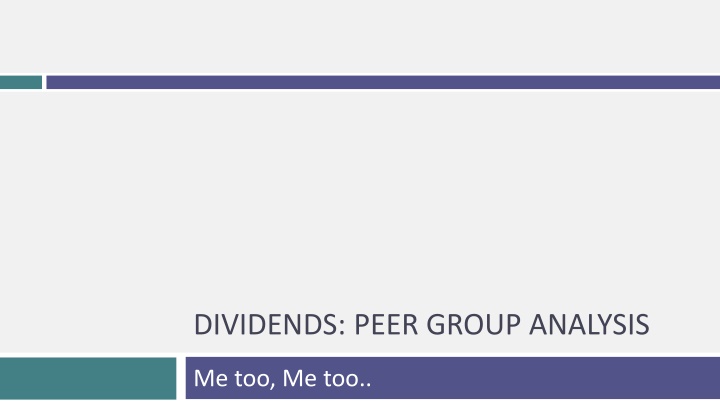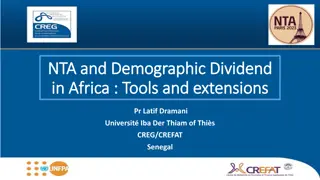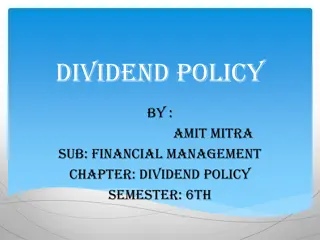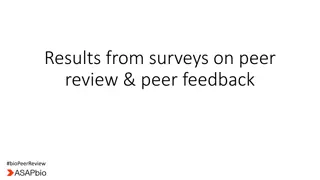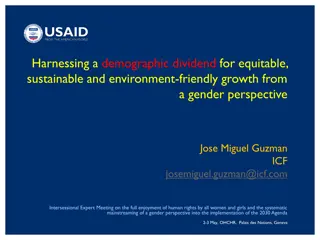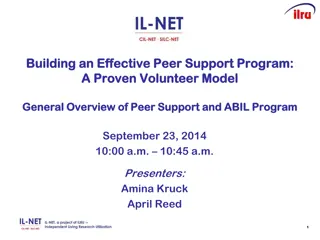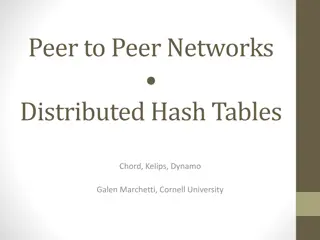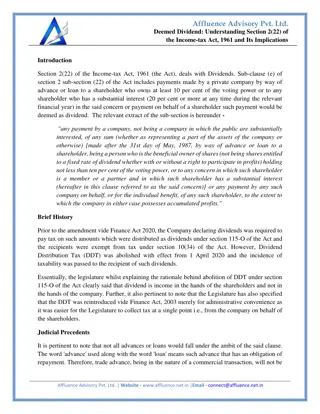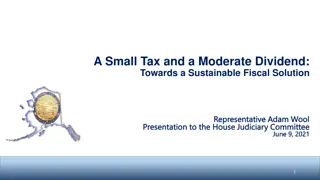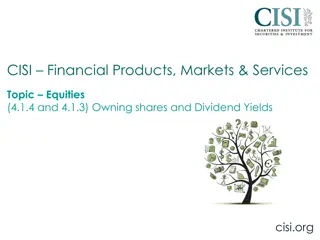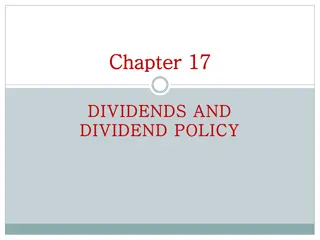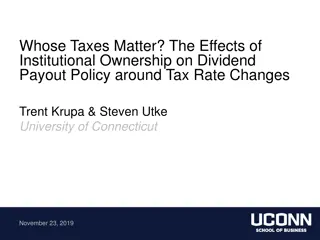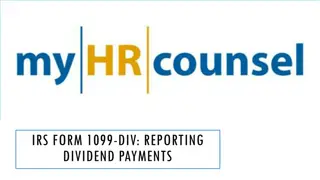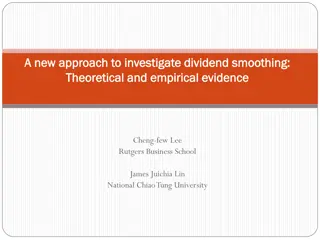Peer Group Dividend Analysis
This content provides insights into conducting a peer group analysis for dividends, comparing different companies in terms of dividend yields and payouts. It discusses the importance of dividend decisions and how companies can evaluate their dividend policies based on industry benchmarks and financial performance metrics.
Uploaded on Mar 13, 2025 | 2 Views
Download Presentation

Please find below an Image/Link to download the presentation.
The content on the website is provided AS IS for your information and personal use only. It may not be sold, licensed, or shared on other websites without obtaining consent from the author.If you encounter any issues during the download, it is possible that the publisher has removed the file from their server.
You are allowed to download the files provided on this website for personal or commercial use, subject to the condition that they are used lawfully. All files are the property of their respective owners.
The content on the website is provided AS IS for your information and personal use only. It may not be sold, licensed, or shared on other websites without obtaining consent from the author.
E N D
Presentation Transcript
DIVIDENDS: PEER GROUP ANALYSIS Me too, Me too..
Set Up and Objective 1: What is corporate finance 2: The Objective: Utopia and Let Down 3: The Objective: Reality and Reaction The Investment Decision Invest in assets that earn a return greater than the minimum acceptable hurdle rate The Financing Decision Find the right kind of debt for your firm and the right mix of debt and equity to fund your operations The Dividend Decision If you cannot find investments that make your minimum acceptable rate, return the cash to owners of your business Hurdle Rate Financing Mix 4. Define & Measure Risk 5. The Risk free Rate 6. Equity Risk Premiums 7. Country Risk Premiums 8. Regression Betas 9. Beta Fundamentals 10. Bottom-up Betas 11. The "Right" Beta 12. Debt: Measure & Cost 13. Financing Weights Dividend Policy 17. The Trade off 18. Cost of Capital Approach 19. Cost of Capital: Follow up 20. Cost of Capital: Wrap up 21. Alternative Approaches 22. Moving to the optimal 24. Trends & Measures 25. The trade off 26. Assessment 27. Action & Follow up 28. The End Game Financing Type 23. The Right Financing Valuation 29. First steps 30. Cash flows 31. Growth 32. Terminal Value 33. To value per share 34. The value of control 35. Relative Valuation Investment Return 14. Earnings and Cash flows 15. Time Weighting Cash flows 16. Loose Ends 36. Closing Thoughts
The Peer Group Approach In the peer group approach, you compare your company to similar companies (usually in the same market and sector) to assess whether and if yes, how much to pay in dividends. Dividend Yield Dividend Payout Company 2013 Average 2008-12 2013 Average 2008-12 Disney 1.09% 1.17% 21.58% 17.11% Comparable Group US Entertainment Dividend Yield 0.96% Dividend Payout 22.51% Global Diversified Mining & Iron Ore (Market cap> $1 b) Vale 6.56% 4.01% 113.45% 37.69% 3.07% 316.32% Global Autos (Market Cap> $1 b) Tata Motors 1.31% 1.82% 16.09% 15.53% 2.13% 27.00% Global Online Advertising Baidu Deutsche Bank 0.00% 1.96% 0.00% 3.14% 0.00% 362.63% 0.00% 37.39% 0.09% 1.96% 8.66% 79.32% European Banks 3
A closer look at Disneys peer group Market Cap $134,256 $79,796 $63,077 $38,974 $4,426 $4,367 $3,894 $3,844 $3,673 $3,013 $2,975 $2,001 $1,245 $1,047 $642 $454 $177 $20,462 Dividends + Buybacks $5,411 $2,477 $4,939 $5,219 $0 $0 $0 $101 $59 $132 $34 $0 $36 $0 $0 $0 $0 $1,083 Net Income $6,136 $7,097 $3,019 $2,395 $142 $232 -$163 $169 $129 $145 -$36 $63 $31 -$16 $96 -$23 -$1 $1,142 Dividend Yield 0.99% 0.52% 1.68% 1.42% 0.00% 0.00% 0.00% 2.64% 0.00% 4.39% 0.00% 0.00% 2.88% 0.00% 0.00% 0.00% 0.00% 0.85% Dividend Payout 21.58% 6.78% 27.08% 23.17% 0.00% 0.00% NA 63.04% 0.00% 77.31% NA 0.00% 317.70% NA 0.00% NA 0.00% 41.28% Cash Company The Walt Disney Company Twenty-First Century Fox, Inc. Time Warner Inc Viacom, Inc. The Madison Square Garden Co. Lions Gate Entertainment Corp Live Nation Entertainment, Inc Cinemark Holdings Inc MGM Holdings Inc Regal Entertainment Group DreamWorks Animation SKG Inc. AMC Entertainment Holdings World Wrestling Entertainment SFX Entertainment Inc. Carmike Cinemas Inc. Rentrak Corporation Reading International, Inc. Average Dividends $1,324 $415 $1,060 $555 $0 $0 $0 $101 $0 $132 $0 $0 $36 $0 $0 $0 $0 $213 FCFE $1,503 $2,408 -$4,729 -$2,219 -$119 -$697 $288 -$180 $536 -$18 -$572 -$52 -$27 -$137 $64 -$13 $15 -$232 Return/FCFE 360.01% 102.87% NA NA NA NA 0.00% NA 11.00% NA NA NA NA NA 0.27% NA 0.00% 79.02% Median $3,673 $0 $34 $129 -$27 0.00% 6.78% 5.63% 4
Going beyond averages Looking at the market Regressing dividend yield and payout against expected growth across all US companies in January 2014 yields: PYT = Dividend Payout Ratio = Dividends/Net Income YLD = Dividend Yield = Dividends/Current Price BETA = Beta (Regression or Bottom up) for company EGR = Expected growth rate in earnings over next 5 years (analyst estimates) DCAP = Total Debt / (Total Debt + Market Value of equity) 5
Using the market regression on Disney To illustrate the applicability of the market regression in analyzing the dividend policy of Disney, we estimate the values of the independent variables in the regressions for the firm. Beta for Disney (bottom up) = 1.00 Disney s expected growth in earnings per share = 14.73% (analyst estimate) Disney s market debt to capital ratio = 11.58% Substituting into the regression equations for the dividend payout ratio and dividend yield, we estimate a predicted payout ratio: Predicted Payout = .649 0.296 (1.00)-.800 (.1473) + .300 (.1158) = .2695 Predicted Yield = 0.0324 .0154 (1.00)-.038 (.1473) + .023 (.1158) = .0140 Based on this analysis, Disney with its dividend yield of 1.09% and a payout ratio of approximately 21.58% is paying too little in dividends. This analysis, however, fails to factor in the huge stock buybacks made by Disney over the last few years. 6
The problem with changing dividends Investors pick companies based on dividend policy and companies generally pick dividend policies that reflect their characteristics (growth, reinvestment needs etc.) When a company s characteristics change, and it needs to change its dividend policy, the clientele may not react well to the change, no matter how well intentioned. 7
Dividend Policy and Clientele Assume that you run a phone company, and that you have historically paid large dividends. You are now planning to enter the telecommunications and media markets. Which of the following paths are you most likely to follow? Courageously announce to your stockholders that you plan to cut dividends and invest in the new markets. Continue to pay the dividends that you used to, and defer investment in the new markets. Continue to pay the dividends that you used to, make the investments in the new markets, and issue new stock to cover the shortfall Other a. b. c. d. 8
Time for a reset on dividends Dividends, as we know them, were designed and structured for equity investments a century ago, when these investments were competing with bonds for investor money. In today s unpredictable and uncertain world, equity investments in most businesses cannot be viewed as bonds (fixed dividend yield) with price appreciation. Thus, the notion of fixed dividends may have to be abandoned for more flexible dividends, and this may already be happening in the shift to buybacks. 9
Task Read Relative to the sector in which your company operates, evaluate whether it returns too much or too little cash. Chapter 11 10
